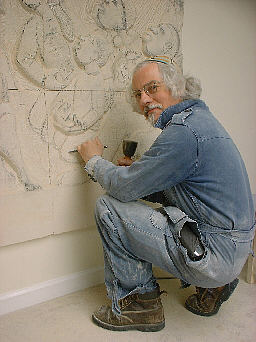St Philips School Odd Down Bath. Hall Stone
Carvings
St Philips is a church school and the Christian faith
informs its operation and this lead the governors of the school to discussed
with the architect their need to visually define the new building in a
Christian context. There was a desire to express this faith in a permanent
way in the new building that not only said, “this is a Christian school”,
but also had some thing to say about the Christian life. So the idea was
born of carving several panels around the building to carry out this
function and because of my experience with community art projects and my
commitment to Christian art I was asked to be involved fairly early on.
Because of constraints on the budget Mr Desmond Barry the architect has
had to scale down the number of panels to two. One is an exterior frieze
over the west doorway, and one is inside in the reception area mirroring the
entrance.
Both are substantial panels allowing for a major work. We are
fortunate enough to have been funded for the stone. The county have paid for
the exterior panel, which is now in position and the school is funding the
interior panel, which is due to be fixed soon.
As you can see the
idea is to carve the panels insitu so that I will be in residence for the
duration of the work, and I can interact with the children through talks and
projects. The theme for the interior panel is the story of the fish and
loaves, which is associated with St Philip the patron saint of the church
and school. This is a good story for the children to be involved and
included in. The exterior panel will show the creation. We hope that the
children will learn both stories, be aware of the Christian faith, and see
how a sculpture is carved in stone. Thus leaving a lasting impression with
them and a lasting statement of our faith in the fabric of the school.
At my own school back in the sixties there were some beautiful paintings
done under supervision by the students. My school was rather special because
although it was a secondary modern, it had a dedicated art course with in
it, giving students 12 lessons of art per week. The schools head master in
the fifties was George Mackley one of Britain’s foremost wood engravers. So
you can imagine these paintings that surrounded every classroom door from
dado to ceiling, the whole length of the corridor were of a particularly
high standard. I tell you this because I want to explain the impact of these
works that we saw each day as we lined up to start a new lesson.
They were pictures of bible stories The wedding feast at Canna and the
raising of Lazarus but they were in modern dress and settings and each
picture had children in our school uniform taking part. The wedding feast
particularly impressed me and I have a clear image of it to this day. It was
set in an English country garden with a colourful; marquee and dancing
children in summer uniform. It gave me a felling of well being and security
as we waited to face another impenetrable forty five minutes of maths.
It is this idea of telling the story of the “Feeding of the five
thousand”
in a contemporary setting that will draw the viewers in and
intrigue them that excites me. Even if the story is not understood
completely the image is stored for reference later. Like me I would like a
person to remember the carving in their school entrance long afterwards and
perhaps ponder on its significance.
